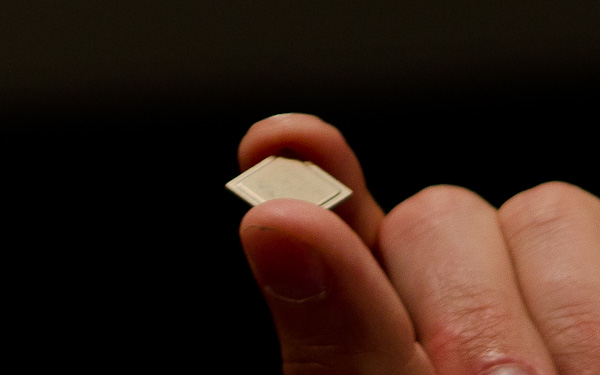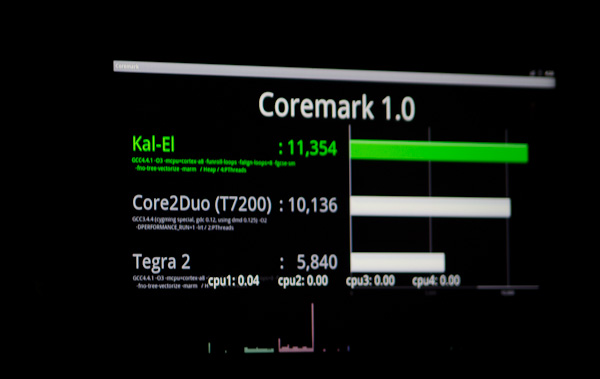NVIDIA's Project Kal-El: Quad-Core A9s Coming to Smartphones/Tablets This Year
by Anand Lal Shimpi on February 15, 2011 9:05 PM ESTFinal Words
The first thing everyone at NVIDIA asked me after I saw Kal-El running was an eager and expected: "well, what did you think?"
On the one hand, we have a clear underdog in the SoC space demonstrating a brand new chip just 12 days after getting it back from the fab. It's functional, it can render 3D games, it can decode high bitrate video and it runs Android today. The word impressive is insufficient to convey the magnitude of what I just described, particularly in the SoC space.
On the other hand, it's still just an announcement. It wasn't too long ago that NVIDIA was struggling to name a single design win. The recent success with LG, Motorola and Samsung is awesome, but it isn't a guarantee of what's to come. That being said, the handset vendors and carriers clearly take NVIDIA seriously today and they would be foolish not to consider Kal-El as it'll be the quickest way to get to quad-core in an Android phone.
Architecturally, Kal-El isn't a huge departure from what we currently have today with Tegra 2. NVIDIA claims a 5x performance improvement over Tegra 2 however that seems a bit optimistic. The 5x gains appear to be from combining the 2x theoretical gain from 2 to 4 cores plus a 3x gain from the new GPU. NVIDIA claims that this is enough to put Kal-El above a Core 2 Duo clocked at 2GHz (see the test results below), however the NVIDIA generated scores seem suspect not to mention that Coremark isn't representative of the sort of workload you'd see on a smartphone/tablet.
If NVIDIA can increase clock speeds a bit we'll see better performance than Tegra 2 on lightly threaded workloads, but I'm not convinced of the gains to be had in single-tasking workloads from four cores in a smartphone/tablet. The bigger gains over Tegra 2 will likely come from any improvements to the memory controller as well as the faster GPU. This being said, NVIDIA does believe that even web page rendering can benefit significantly from a quad-core CPU so I could be very well proven wrong once devices are out in the wild.
If NVIDIA can secure significant design wins with Kal-El based tablets in August of this year and smartphones in Q4 I will be beyond impressed. NVIDIA gets major points for putting on good demos of working silicon today but in this business you need to have devices. For now we play the waiting game. I suspect if you're not taking NVIDIA seriously at this point, you really should be.












76 Comments
View All Comments
theagentsmith - Wednesday, February 16, 2011 - link
There is the Mobile World Congress happening right now in the nice city of Barcelona.... almost every company involved in mobile electronics sector is showing off new products, that's why you see only news about smartphones!R3MF - Wednesday, February 16, 2011 - link
nvidia, you have not lost the magic!Dribble - Wednesday, February 16, 2011 - link
@40nm the power draw would be too high for a phone so I don't suppose there's much point having this processor in one until 28nm arrives.However for the new tablet market you have larger batteries so you can target them with a higher power draw soc (it's still going to be much much smaller then any x86 chip and I expect the big screen will still be sucking most of the power).
Impressive they got it working first time, puts a lot of pressure on competitors who are still struggling to catch up with tegra 2 let alone compete with this.
SOC_speculation - Wednesday, February 16, 2011 - link
Very cool chip, lots of great technology. But it will not be successful in the market.a 1080p high profile decode onto a tablet's SXGA display can easily jump into the 1.2GB/s range. if you drive it over HDMI to a TV and then run a small game or even a nice 3D game on the tablet's main screen, you can easily get into the 1.7 to 2GB/s range.
why is this important? a 533Mhz lpddr2 channel has a max theoretical bandwidth of 4.3GB/s. Sounds like enough right? well, as you increase frequency of ddr, your _actual_ bandwidth lowers due to latency issues. in addition, across workloads, the actual bandwidth you can get from any DDR interface is between 40 to 60% of the theoretical max.
So that means the single channel will get between 2.5GBs (60%) down to 1.72 (40%). Trust me, ask anyone who designs SOCs, they will confirm the 40 to 60% bandwidth #.
So the part will be restricted to use cases that current single core/single channel chips can do.
So this huge chip with 4 cores, 1440p capable, probably 150MT/s 3D, has an Achilles heel the size of Manhattan. Don't believe what Nvidia is saying (that dual channel isn't required). They know its required but for some reason couldn't get it into this chip.
overzealot - Monday, February 21, 2011 - link
Actually, as memory frequency increases bandwidth and latency improve.araczynski - Wednesday, February 16, 2011 - link
so if i know that what i'm about to buy is outdated by a factor of two or five not even a year later, i'm not very likely to bother buying at all.kenyee - Wednesday, February 16, 2011 - link
Crazy how fast stuff is progressing. I want one...at least this might justify the crazy price of a Moto Xoom tablet.... :-)OBLAMA2009 - Wednesday, February 16, 2011 - link
it makes a lot of sense to differentiate phones from tablets by giving them much faster cpus, higher resolutions and longer battery life. otherwise why get a tablet if you have a cell phoneyvizel - Wednesday, February 16, 2011 - link
" NVIDIA also expects Kal-El to be somewhere in the realm of the performance of a Core 2 Duo processor (more on this later)."I don't think that you referred to this statement anywhere in the article.
Can you elaborate?
Quindor - Wednesday, February 16, 2011 - link
Seems to me NVidia might be pulling a Qualcomm, meaning they are going with what they have and are trying to stretch it out longer and wider before giving us the complete redesign/refresh. You can see this quite clearly at the MWC right now.Not a bad strategy as far as I can tell right now. Only threat that I see is that Qualcomm is actually scheduled to release their new core design around the time Nvidia will releasing the Kal-El.
So who's going to win that bet? ;) More IPC VS Raw Ghz/cores. Quite a reversed world too if you ask me, because Qualcomm was never big on IPC and went for the 1Ghz hype.
Hopefully NVidia doesn't make the same mistakes as with the GPU market, building such a revolutionary designs that they actually design "sideways" from the market. Making their GPU's fantastic in certain area's, which might not take off at all.
Mind you, I'm an NVidia fan... but it won't be the first time NVidia releases a revolutionary architecture, which isn't as efficient as they thought it would be. ;)